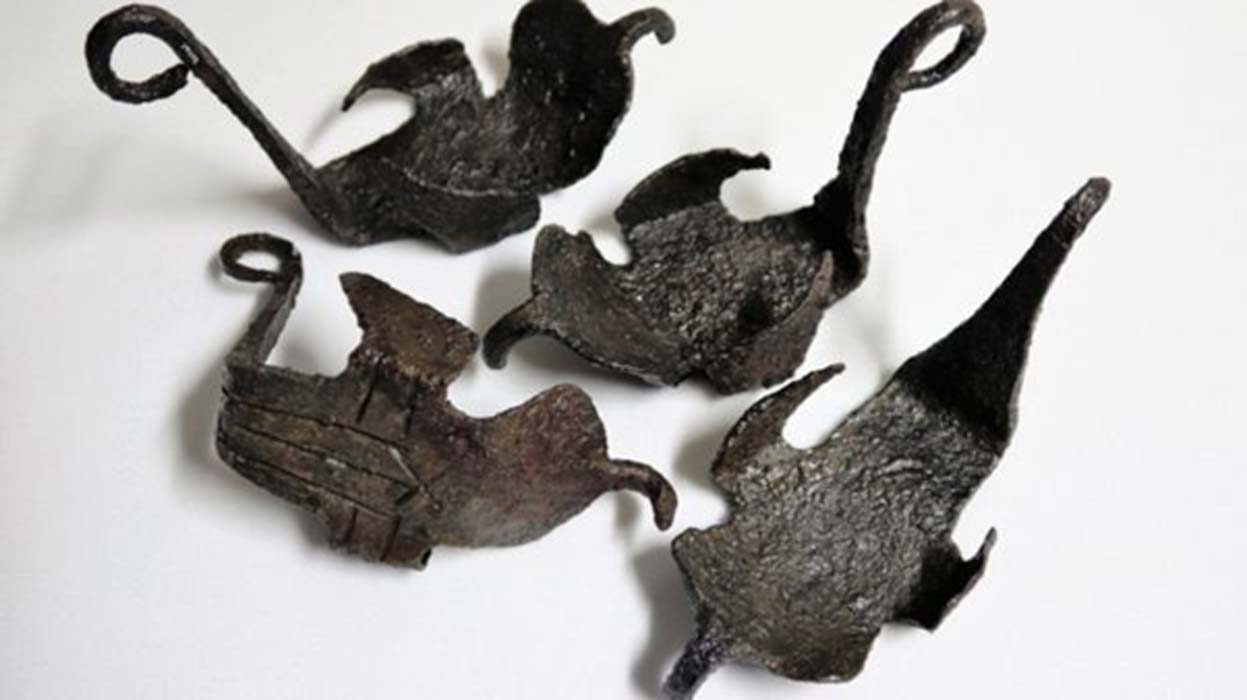Ironclad Hoof: Unique Roman Horse Shoes Found on Hadrian’s Wall
The BBC is reporting an exciting find on the famous Hadrian’s Wall in the North of England. Four Roman era horseshoes were unearthed during a planned dig at the site of the ruined Vindolanda fort. While the find is not the most dramatic, it is an exciting one as there have been relatively few horseshoe sets found and they provide deeper understanding of life on Hadrian’s Wall and how the Romans used horseshoes and worked their horses.
When Romans build walls
The Romans occupied much of Britain from the first to the fifth century AD. In the 2 nd century AD, Emperor Hadrian, concerned by the threat posed by the Picts who lived in modern Scotland, decided to create a defensive line to protect northern England. The wall was made of stone and turf and it had towers and forts that were manned by Roman forces. The wall stretches from the Irish Sea to the North Sea and extensive sections remain standing to this day. It was abandoned by Rome in the early 5 th century AD when they evacuated Britain in the face of mounting barbarian attacks.
The Vindolanda treasure trove
The shoes were found at Vindolanda, which is located in Hexham, Northumbria, and was an important fort on the wall. It is believed that the fort predates the construction of Hadrian’s Wall and it guarded an important road. The fort is very well-preserved and there have been many important discoveries at the site, one of the best known being the Vindolanda tablets, a set of wooden tablets. These are letters and other documents, often written by ordinary soldiers and civilians, that provide us with an unparalleled insight into the everyday life of Romans on the Northern edge of the Empire. Other famous finds at the site are everyday items including many shoes, and very recently a bronze hand and what seem to be an early set of Roman boxing gloves. The fort is at present administered by the Vindolanda Trust and ongoing excavations offer up a continual supply of noteworthy finds.
- Two Roman Cavalry Swords and Two Toy Swords Amongst Treasures Found at Frontier Fort
- The Mighty Wall of Hadrian, Emperor of Rome
- 1,000-year-old Viking Sword in Extraordinary Condition Discovered in Ireland
Shoes of the equestrian kind
The horseshoes were found by a volunteer during a dig at the fort. There are roughly 250 volunteers who carry out excavations at Vindolanda under the supervision of the Western's Field School, which was founded to train students in archaeology and field excavation. According to the BBC, a curator at the UNESCO listed site said “it was incredibly rare to find a full set of Roman horseshoes.”
A preliminary investigation indicates that the shoes date from between ‘140 to 180 AD’ reports the Archaeology website. They are very well preserved because there is very little oxygen in the soil, which means that they did not rust. The oxygen starved soil is the reason why so many well-preserved treasures have been found at Vindolanda archaeological site.

The hipposandals, which were found by a volunteer, are well-preserved. (Image: Vindolanda)
Hipposandals
The odd-looking horseshoes were known to the Romans as ‘hipposandals. According to Phys.Org, “The unearthed hipposandals are more like actual shoes, resembling ‘soup ladles’ which would wrap around the sole of a horse's foot.” The shoes can be best understood as foot protectors for horses and it seems that they were peculiar to the Western Roman provinces. It has been argued that they were mainly used on horses in rocky and hilly terrain.
The discovery is important because usually only one hipposandal is found at a time. It is assumed the shoes were deposited together because they belonged to one horse. According to Phy.Org, it is speculated that ‘somebody's favorite horse died, and they buried the hipposandals as a deliberate memorial’. The shoes do not have any inscription that could indicate the identity of the horse or its rider.
- Giddyap! How the Stirrup Revolutionized Horseback Riding and Helped Build Empires
- Ancient Horse Burials of the Bronze Age: Folklore and Superstition
- 2,000-Year-Old Remains of Horse Killed by Pompeii Volcano Found in Tomb Raider Tunnel

It is extremely unusual to find a full set of hipposandals. (Image: Vindolanda Trust)
These horseshoes are challenging the assumption that ‘hipposandals’ were used only for beasts of burden. It would seem that the discovery of a full set of shoes at a military fortress would indicate that they were also used by Roman cavalry. The discovery of the odd-shaped shoes in the rolling landscape of Northern England would indicate that they were much more widely used than previously believed.
The discovery of the unique horseshoes once again emphasizes the importance of Vindolanda as an invaluable source of historical wonders and demonstrates that there are potentially many more discoveries to be made at the location. The find is also allowing us to understand how the Romans managed horses and that the ‘hipposandals’ were probably used by the cavalry, possibly in a variety of terrains.
The distinctive horseshoes are expected to go on public display in the near future at the Greenhead Roman Army Museum.
Top image: A set of four ‘hipposandals’ or Roman horseshoes found at Vindolanda. Source: Vindolanda Trust
By Ed Whelan

















